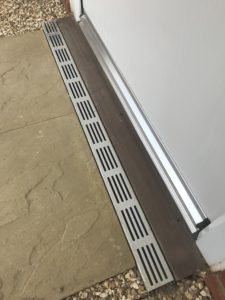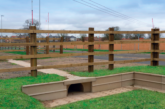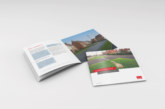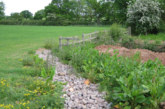William Poynter, Design Service Advisor at ACO Water Management, explains the key challenges builders face when considering drainage systems and how to overcome them.
The first thing any developer or builder should think about when designing a drainage system for a housing development is where the rainwater will flow. When you’re focusing on driveways, for example, you need to be aware of the falls on-site and design the channels accordingly. As for doorways, be aware which threshold is required as channels along the entrance of the property are a necessity.
Channel depths are also extremely important. Some building sites have restrictions as to the depth of the channel system, which would rule out certain channel sizes. ACO, for example, can provide domestic channel systems which have a depth ranging from 80 to 250mm and can design the system to the property. Deeper channels are recommended, especially for driveways, but if that’s not possible systems can be widened to ensure it provides the necessary volume.

Impact on design
One of the first challenges for many specifiers for domestic projects is maintaining a quality finish for all aspects of the works. Understandably, customers want to create a certain appearance for their homes: one that showcases premium quality. This desire stretches to water drainage systems and therefore when considering which systems to go for, contractors will want to avoid unpleasant finishes.
 For example, some customers want drainage systems to be subtle and barely noticeable. While car parking areas will require traditional gratings, other areas of the new build house could utilise more slotted drainage. These systems, such as ACO’s BrickSlot range, are inserted seamlessly between brickwork to provide a clean and contemporary finish.
For example, some customers want drainage systems to be subtle and barely noticeable. While car parking areas will require traditional gratings, other areas of the new build house could utilise more slotted drainage. These systems, such as ACO’s BrickSlot range, are inserted seamlessly between brickwork to provide a clean and contemporary finish.
Staying with the aesthetics, more customers are looking for their rainwater pipes to connect to the channel system as a single unit. Historically, contractors have cut the grating to enable the pipe to fit or design the rainwater pipes so they hover just above the grating. This often leads to water splashing onto the grating and causing puddles, as well as an undesired finish.
However, utilising downpipe connectors allows the rainwater pipe to seamlessly connect with the channel system. Customers can therefore receive an aesthetically-pleasing connection which is not only durable, but also avoids splashing.
A Class(y) solution
Ensuring that any drainage channel meets the appropriate load class is essential, especially for driveways. With consumer shopping habits changing, heavy loads from turning delivery vehicles are becoming more frequent, and therefore ensuring the grating can cope with heavier loads, and not buckle under pressure, is essential.
With this in mind, B 125 rated systems should be installed for private car parks or areas where domestic vehicles will be present. For other areas of the house, such as patios and garage thresholds, A 15 rated drainage is sufficient.
Leaving time
Once the systems are installed, one of the biggest challenges is maintenance, especially if surrounded by trees and shrubbery. Leaves falling into the gratings and causing blockage can seem unavoidable, but it can be easily managed.
When using traditional channels, gratings can be simply lifted and cleared with ease. However, with the more subtle systems, such as BrickSlot, where the bulk of the channel sits underground, it has a very thin slot which rises to ground level and gathers water, offering a discreet finish.
As the channel sits underground, it means there is no grating to lift and clear of any debris. If these systems are requested, developers need to specify access channel units located at relevant intervals, which can be lifted and cleared.
Final thoughts
As new build developments continue to grow in demand, and with unpredictable weather patterns in the UK, drainage systems are essential to ensure customers remain happy and potential problems are addressed. Channel systems aren’t always the number one priority, but they need to be carefully considered, especially given how prone the UK is to adverse weather. We would recommend speaking to a water management specialist, or your local merchant, for advice on installation and the different options available.









